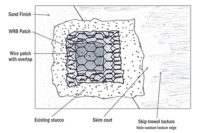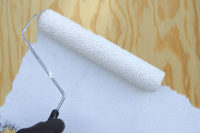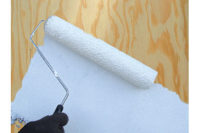In this article, learn about...
- continuous insulation (CI)
- how an exterior insulation and finish system (EIFS) provides CI
- what makes up an EIFS.
Ever wonder what it would be like if you couldn’t just flip a switch to heat or cool your indoor environment? Or if you weren’t able to simply plug a device into a receptacle to use it? Our civilized culture has created an intricate network of power that is safely available to us for our discretionary use. It’s really a pretty cool thing when you think of the convenience of using a given device by just plugging it into a receptacle. Our ever increasing demand for this convenience is putting a strain on the cost of making and delivering the energy. In fact, the cost of energy has hit a tipping point.
We have burned coal, dammed up rivers, used nuclear technology, and harvested the wind and sun—all to make available power. But what we really haven’t done is slowed the demand. The buildings we inhabit consume 40 percent of all the power produced. Of that, 40 percent is used to heat and cool our buildings. So, if you haven’t been asleep or in a cave for the past five years, you already know that the building industry and its building codes are changing to address this very issue. Now, buildings must meet minimum energy efficiency requirements and these requirements will become more stringent in the years to come. It’s a fact: we are building differently and will continue to do so in the future.
I know you’re thinking “old news, Albert” but wait, there’s more. In order to meet these new current energy efficiency requirements, our claddings must use continuous insulation.
ASHRAE 90.1–2010 defines CI as, “Insulation that is continuous across all structural members without thermal bridges other than fasteners and service openings. It is installed on the interior or exterior or is integral to any opaque surface of the building envelope.” So, for all climate zones in the U.S., except 1 and 2, cavity insulation alone will not meet the energy efficiency requirements. Consider an assembled wall unit. (See illustration). The framing members (studs) account for approximately 25 percent of the wall assembly. Insulation is placed between the members in the cavity, as a means to insulate our interior environment. These members actually act as thermal bridges that allow for the transference (I like to think of it as a secret passage way) of heat and cold, known as thermal bridging. So, the money spent to heat and cool our buildings can escape through these thermal bridges, thus, further increasing our demand and cost for energy.
RE-INTRODUCING EIFS
In the past, stucco has been applied over CI and has performed very well. I’ll talk in detail about that in the next column. This column will illustrate the high CI performance of my other subject matter: A long established, fully tested cladding called exterior insulation and finish system. EIFS is truly, by definition, a continuous exterior insulation cladding. It is a system based on continuous insulation and achieved by being adhesively applied to an approved substrate. There are some EIF systems that are mechanically attached but they are an exception.
By system, I mean that there are no interchangeable pieces and parts or different combinations of “things” to achieve a CI cladding. The system components are a choreographed combination of performance products from a single source manufacturer. These EIF systems can be applied to new construction, as well as be applied over existing claddings. EIFS were created as a CI cladding and were the first kids on the block to provide CI.
EIFS came to the U.S. in the late-60s and gained popularity during the energy crisis of the 1970s. The flagship EIF system was known as a barrier system with the basecoat and mesh layer being the weather barrier. Fast forward to our current construction times and EIFS is now applied in most cases with a secondary barrier, and this is where we will start.
The secondary barriers of an EIF system are monolithic in that they are a liquid, applied by roller, spray or trowel to a given substrate. This continuous barrier extends into the fenestrations too. So right off the get-go EIFS provides a monolithic (continuous) secondary barrier. These secondary barriers all provide moisture protection for the substrate, prevent air infiltration, and are also available as either vapor permeable or as a vapor barrier. The vapor barrier versions may be beneficial in colder climates that might require it. Most EIFS manufacturers provide both versions.
WHAT MAKES UP AN EIF SYSTEM
So there are the suspenders, let’s look at the belt. The rest of the system: foam, basecoat, mesh and finish, a complete barrier system, doubles the protection of the building against moisture intrusion. The most widely used foam, expanded polystyrene, is applied to the secondary barrier in a running bond pattern and because it is adhered, there are no penetrations of the secondary barrier. The entire perimeter of each sheet is butted tightly against the adjacent sheet forming a continuous insulation layer. The EPS foam is made of fused polystyrene beads which trap air between each bead, offering a superior insulation. Since there is no edible food source in foam, mold will not grow within it.
Because foam is applied to the exterior of the wall assembly, the R-value provided by the foam component is a true value, no loss of heat or cold via thermal bridging. By sheer nature of the makeup of EPS foam, thermal movement is absorbed within the foam itself minimizing the chances of cracking in the lamina due to thermal expansion and contraction. Some of the newer EIF systems now are using extruded expanded polystyrene (XPS) which carries a higher R-value than EPS does. XPS or EPS function similarly as a continuous insulation layer. As good as they are at insulating; neither should be run below grade or used as a roofing product (applied horizontally in widths larger than 18 inches) as this may compromise their integrity.
BASECOAT AND MESH LAYER
The real workhorse of an EIF system is the basecoat and mesh layer. This is the first line of barrier defense to fighting moisture intrusion. This layer must cover 100 percent of any exposed foam to protect the insulation against the environment and to contain foam in fire situations. This layer, like the two under it, is also monolithic, and continuous. It is a simple component functioning in a complex way, fighting moisture, fending off UV degradation, and moving with the foam during the daily dance known as thermal expansion and contraction, without becoming compromised.
FINISH LAYER
The final component is the finish. Yes, this layer helps to shed surface water but primarily it is there to look awesome. By shedding surface water the finish helps to keep the cementitious basecoat from efflorescing. And like the layers below it, it is a continuous layer of protection. The EIFS finishes are made from high quality acrylics and can last for many years maintaining a newly applied appearance.
There are many new assemblies utilizing CI that all contain varying degrees of complexity. The reality is that any common cladding can be applied over a CI layer. Many times though, figuring out how to properly terminate, or integrate various components—or making sure that all of the parts and pieces fit and work together, can have a contractor or designer pulling their hair out. EIFS has been present for many years and might even be thought of as a common item, one that everyone knows is there, but lacks a “new complexity” appeal. However, when one dissects continuous insulation and defines the intent and performance of a CI cladding, EIFS falls in as the “true” definition of CI.






